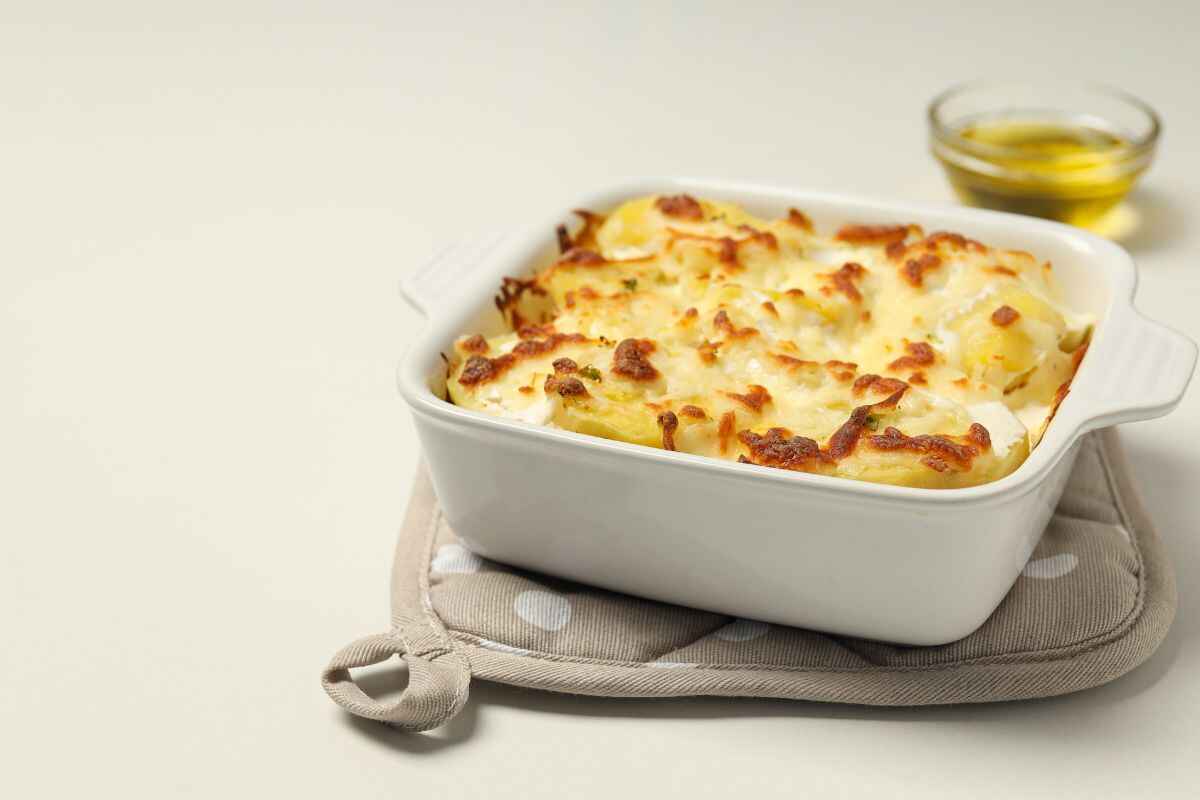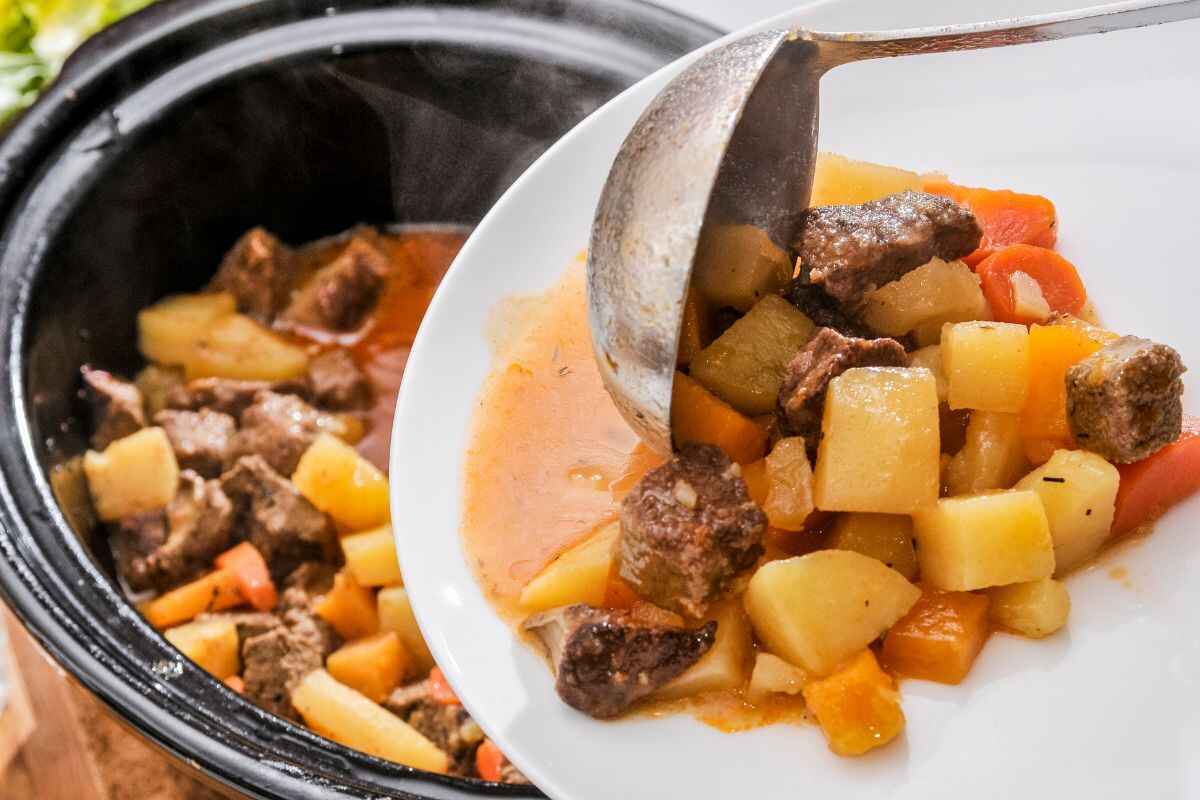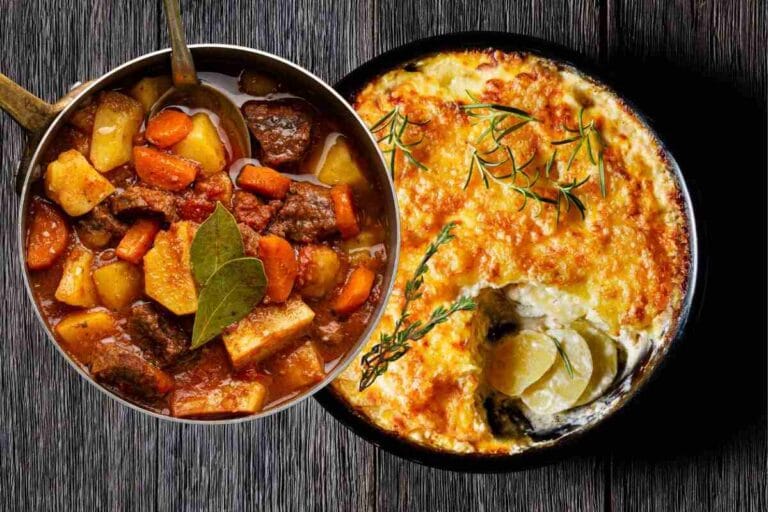The Difference Between A Stew And A Casserole? Understanding the difference between a stew and a casserole might feel tricky at first. Both are warm, comforting dishes, perfect for a family dinner or a cozy night in. But they have unique characteristics that make them special in their own way. Let’s dive into the details to uncover what sets them apart and how you can choose the right dish for any occasion. 😊
Table of Contents (The Difference Between A Stew And A Casserole?)
Introduction to Stews and Casseroles
Stews and casseroles have been staples in kitchens around the world for centuries. Why? They’re simple, versatile, and downright delicious. Whether slow-cooked in a pot or baked in the oven, these dishes deliver hearty flavors and textures that are hard to beat.
But here’s the catch: people often confuse the two! Is a stew just a runny casserole? Or is a casserole a baked version of a stew? Let’s break it down and figure out the real differences between these two beloved dishes.
Defining a Stew
Stews are a true classic. They are slow-cooked, one-pot dishes made by simmering ingredients in liquid over a long period. The result? A rich, flavorful dish with tender meat and soft vegetables that practically melt in your mouth.
Key Ingredients in a Stew
The ingredients for a stew are simple and straightforward:
- Meat: Beef, chicken, or lamb are common, but seafood and vegetarian stews also shine.
- Vegetables: Potatoes, carrots, onions, and celery are classic choices.
- Liquid: Broth, stock, or even wine is used as the base.
It’s all about building flavors slowly, layer by layer. The low and slow cooking method makes the magic happen.
Cooking Methods for Stews
A stew is typically cooked on the stovetop or in a slow cooker. The idea is to keep it at a low simmer for hours, allowing the flavors to blend beautifully.
Pro Tip: A Dutch oven is your best friend for making a stew. Its heavy lid helps lock in moisture, creating a rich and hearty dish.
Common Types of Stews
From continent to continent, stews come in endless varieties:
- Beef Bourguignon (France): A wine-based stew with beef and mushrooms.
- Irish Stew: A lamb and potato stew that’s perfect for chilly days.
- Chili (USA): A spicy stew made with ground meat, beans, and tomatoes.
Each culture has its own twist, proving that stews are truly universal. 🌍
Defining a Casserole
Casseroles are equally versatile but take a different route when it comes to preparation. Unlike stews, casseroles are baked dishes. Everything is mixed together and cooked in an ovenproof dish until golden and bubbly.
Typical Ingredients in a Casserole
Here’s what you’ll usually find in a casserole:
- Protein: Chicken, ground beef, or fish.
- Starch: Rice, pasta, or potatoes act as the base.
- Topping: Often, casseroles are topped with cheese or breadcrumbs for extra texture.
The result is a layered dish that’s hearty and satisfying.
How Casseroles Are Cooked
Casseroles are cooked in the oven, which sets them apart from stews. The baking process creates a crispy or golden topping while locking in all the flavors underneath.
Fun Fact: The word “casserole” comes from the French word for the pan it’s baked in!
Popular Casserole Recipes
There are countless casseroles to enjoy, such as:
- Tuna Casserole: A creamy, cheesy dish perfect for weeknights.
- Shepherd’s Pie: A casserole with a mashed potato topping and ground meat filling.
- Green Bean Casserole: A holiday favorite made with green beans and fried onions.
Each one is as delicious as the next, and they’re all easy to customize.

Comparing Stews and Casseroles
So, what’s the real difference? Let’s break it down further.
Differences in Cooking Techniques
The most obvious difference lies in how they’re cooked. Stews are simmered slowly on the stovetop or in a slow cooker, while casseroles are baked in the oven. This impacts the texture:
- Stews are rich and soupy.
- Casseroles are firm and layered.
Ingredient Variations Between Stews and Casseroles
While both dishes use similar ingredients—meat, veggies, and starches—the proportions differ. Stews rely on a large amount of liquid for cooking, whereas casseroles need just enough liquid to keep them moist as they bake.
How Serving Styles Differ
Stews are often served in bowls with bread on the side, while casseroles come in slices or portions straight from the baking dish.
Quick Tip: If you’re looking for something more portable, casseroles are the way to go!
Common Misconceptions About Stews and Casseroles
Despite being popular and beloved dishes, stews and casseroles are often misunderstood. Let’s clear up some of the most common misconceptions about these two comforting meals.
Are They Interchangeable?
One big misunderstanding is that stews and casseroles can be swapped out for one another without much change. While it’s true they share similar ingredients, the cooking methods are quite different. A stew cooked in a casserole dish won’t develop that golden, crispy top that casseroles are known for. Likewise, a casserole cooked as a stew may end up too watery or lack structure.
Myths About Their Origins
Another misconception is that stews and casseroles always originated from high-class cuisines. The truth? Both dishes were born out of practicality. They were created to make the most of simple, inexpensive ingredients, feeding families with little effort and maximum flavor.
Block Quote: “The beauty of stews and casseroles lies in their simplicity. They take humble ingredients and transform them into something special.”
Choosing Between a Stew and a Casserole
How do you decide whether to make a stew or a casserole? The choice often depends on the occasion, the equipment you have, and how much time you’re willing to spend in the kitchen.
Factors to Consider: Occasion, Equipment, and Time
- Occasion: If you’re hosting a dinner party, casseroles are perfect for serving straight from the dish. Stews, on the other hand, are great for casual meals or cozy nights in.
- Equipment: Stews require a pot or slow cooker, while casseroles need an ovenproof dish.
- Time: Stews often take longer because of the slow simmering process, whereas casseroles bake faster once prepped.
Tips for Pairing Sides with Each Dish
Pairing the right side dish can elevate your meal:
- Stews go well with crusty bread, rice, or mashed potatoes to soak up the flavorful broth.
- Casseroles are best served with a fresh salad, steamed vegetables, or garlic bread.
Emoji Tip: 🥗 Salad adds a refreshing crunch to balance the richness of a casserole!
Problems and Solutions in Cooking Stews and Casseroles
Even experienced cooks can run into issues when making stews or casseroles. Let’s tackle some of the most common problems and how to fix them.
How to Avoid Overcooked or Undercooked Ingredients
In stews, it’s all about timing. Adding vegetables too early can make them mushy, while adding them too late leaves them undercooked. For casseroles, slicing ingredients evenly ensures everything bakes at the same rate.
Fixing Flavor Imbalances
If your stew tastes too bland, add a splash of vinegar or a pinch of salt to bring out the flavors. For casseroles, seasoning each layer as you build it ensures a well-rounded taste throughout the dish.
Tips for Perfect Texture
For stews, the goal is a thick, hearty broth. If it’s too watery, remove the lid during the final simmer to let some liquid evaporate. In casseroles, layering cheese or breadcrumbs on top creates a crispy texture that contrasts with the creamy filling below.
Nutritional Differences Between Stews and Casseroles
When it comes to nutrition, stews and casseroles can offer both hearty indulgence and healthy options. The key lies in how you prepare them and the ingredients you use. Let’s dive into how these dishes stack up nutritionally and how you can make them work for your diet.
Which Is Healthier?
There’s no straightforward winner—it depends on the recipe! However, here are some general points to consider:
- Stews: Typically, stews are lighter because they rely on broth or stock as a base instead of rich creams or cheeses. They’re often packed with vegetables, making them a great source of vitamins and minerals.
- Casseroles: While casseroles can be richer due to added dairy or starches, they’re also highly customizable. Substituting heavy ingredients with healthier options like low-fat cheese or whole-grain pasta can significantly reduce calories and fat.
Pro Tip: Stews tend to have fewer calories per serving because of their high water content, making them an excellent choice for a lighter meal.
Modifying Recipes for Dietary Needs
Both stews and casseroles are incredibly versatile, making it easy to tailor them to different dietary requirements:
- Low-Carb Options: For stews, skip the potatoes and use cauliflower or turnips instead. For casseroles, try zucchini noodles or spaghetti squash as a base.
- Vegetarian or Vegan: Use plant-based proteins like lentils or tofu in stews and casseroles. Swap out dairy for almond milk or cashew cheese in casseroles.
- Low-Fat Alternatives: Use lean meats like chicken or turkey in stews and opt for reduced-fat cheeses and creams in casseroles.
Stews and Casseroles Around the World
Both dishes are beloved globally, with each culture putting its own spin on these comfort food classics.
Global Variations in Stews
Stews are a worldwide favorite, with unique versions in nearly every region:
- Gumbo (USA): A spicy, thick stew with seafood, sausage, and okra.
- Tagine (Morocco): A flavorful stew made with meat, dried fruits, and spices like cinnamon and cumin.
- Sinigang (Philippines): A tangy stew featuring pork or shrimp and flavored with tamarind.
Unique Casserole Recipes by Region
Casseroles are beloved worldwide, but each region puts its own spin on this versatile dish. Let’s take a closer look at some of the most popular and unique casserole recipes from around the globe.
Moussaka (Greece)
Moussaka is a Mediterranean favorite known for its rich, flavorful layers. The dish starts with slices of tender eggplant, often lightly fried or roasted. Next comes a savory layer of ground meat, typically lamb or beef, seasoned with cinnamon, nutmeg, and other warm spices. The final layer is a creamy béchamel sauce, poured generously on top and baked until golden and bubbly.
It’s a casserole that combines the earthy flavors of vegetables with the heartiness of meat and the silkiness of sauce, making it a must-try for anyone who loves Greek cuisine.

Enchilada Casserole (Mexico)
This Mexican-inspired dish takes all the delicious elements of enchiladas and turns them into an easy-to-make casserole. Instead of rolling individual tortillas, you layer them in a baking dish, alternating with beans, seasoned meat, or vegetables, and plenty of cheese.
The casserole is then topped with enchilada sauce and baked until the cheese is melted and gooey. It’s a crowd-pleaser that’s perfect for weeknight dinners or casual gatherings. Add a dollop of sour cream and a sprinkle of fresh cilantro for the perfect finishing touch!
Fish Pie (United Kingdom)
A British classic, fish pie is a comforting and creamy casserole with a mashed potato topping. The base is a rich, creamy filling made with chunks of fish like cod, salmon, or haddock, often mixed with prawns or other seafood. The filling is enhanced with a white sauce flavored with herbs like parsley and sometimes a touch of mustard.
The dish is topped with a layer of buttery mashed potatoes, spread evenly or piped for a decorative look. Once baked, the topping becomes golden and slightly crisp, while the filling stays creamy and packed with seafood flavors. It’s a dish that feels like a warm hug on a cold day.
Each of these casseroles brings its own regional flair and flavor profile to the table, showcasing the creativity and diversity of global cuisines! 🌍
Emoji Tip: 🌍 Cooking these global dishes is a great way to explore new flavors without leaving your kitchen!
FAQs About Stews and Casseroles
What’s the easiest way to thicken a stew?
- Add a slurry made from cornstarch and water, or mash some of the vegetables into the broth.
Can I freeze casseroles with dairy in them?
- Yes, but they may separate slightly when reheated. Stirring while reheating helps restore their texture.
What’s the ideal cooking time for a stew?
- Most stews need at least 2-3 hours to allow the flavors to fully develop.
How can I prevent a casserole from drying out?
- Cover it with foil while baking and remove it during the last 10 minutes to brown the top.
Are stews or casseroles better for meal prep?
- Both are great options! Stews reheat quickly, while casseroles hold their shape better for leftovers.
Conclusion: Choosing the Right Dish for Your Table
Stews and casseroles each bring something special to the table. Stews are perfect for a warming, hearty bowl of comfort, while casseroles offer a structured dish with crispy, cheesy toppings that’s ideal for sharing. The best part? Both are endlessly adaptable, so you can make them your own.
So, what will it be tonight? A simmering pot of stew or a bubbling casserole fresh out of the oven? Either way, you’re in for a treat. Happy cooking! 😊

